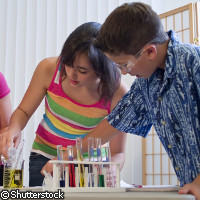GAPP investigates gender-science career link
Does gender play a key role in determining whether someone will follow a science and technology (S&T) career? To tackle this burning question, the GAPP ('Gender awareness participation process') project, funded under the EU's Sixth Framework Programme with EUR 808,380, investigated gender differences in the choice of a science career. The results of the project were presented at the GAPP final conference in Brussels on 4 November. The findings of the two-year project showed that there are no decisive differences between women and men in terms of education choices and job opportunities. But the partners expressed their concern that students do not have a clear concept of what is actually available on the job market. Their assumptions are based on their experiences with subjects and experiments at school, the researchers said. Project participants noted their desire to gain more knowledge about S&T professions, the researchers noted. 'The participants told us of the importance of practice in S&T and see S&T as strongly linked with reality,' they said in a statement. The results also indicated that the younger a person is when gaining S&T experience, the better. Based on the students' feedback, science is, on the one hand, interesting, fun and challenging. On the other, science as a school subject is boring, complex and difficult work. But the results showed that no major gender differences existed in relation to career opportunities. What does exist, said the partners, was a 'generation gap' in attitudes towards gender issues. There was no agreement on any gender-based limitations or restrictions for the young girls, but female teachers (excluding the young generation) seemed to agree with an 'order of gender', where women are still battling stereotypes, while juggling careers and family duties. The project was carried out by institutions and science centres committed to communicating science through accessible, interactive exhibits and programmes. The research institutions focused on three main types of activities: qualitative research, participatory workshops bringing together students and experts from S&T fields, and pilot activities. The GAPP partners explained that the first phase of the project spotlighted the qualitative research. The team established 64 focus groups during this phase. The groups investigated how the perception of science and science careers influence peoples' interest, motivation and subject choice at school, university and in their professional lives. The results showed that girls are inclined to place more emphasis on the social outcomes of S&T (i.e. health issues) but are more critical of contemporary science, while boys are drawn more to the success that some leading male scientists or technological entrepreneurs have achieved. Teachers, parents and personal interests also shape the career direction of a student. Another factor affecting the perception of S&T and the choices made in relation to this field is that scientists are typically thought of as being males. Interviews were also conducted with 60 opinion leaders, including scientists, politicians and experts in gender issues. The second phase of the project involved 'Open space technology' workshops. 'The partners were able to identify the ideas, the interests, [and] the needs of the young people, especially young girls, and of scientists, teachers and parents, on S&T studies and their related careers,' the researchers said. The next phase focused on the realisation of pilot activities: this included presenting students and parents in Denmark with role models to motivate them, as well as engaging them in group discussions; working in S&T laboratories in Italy; and launching a scientist's blog in Portugal. In Belgium, students met and talked with female scientists, and a competition in filming for young people was launched in the Netherlands, while a film about the lives of two young scientists was produced in Poland. In total, 6 countries, 26 research institutes, 40 researchers, 1,817 students from various schools, 87 teachers and 207 parents were involved in this phase. The last phase evaluated the pilot activities. According to the partners, the activities were 'a great success among all the participants', and they added that 'the students' awareness on who a scientist [...] is and what they do has considerably changed'. Both the researchers and teachers offered great feedback on the pilot activities, and many students expressed strong interest in continuing the activities. The work showed encouraging results, with students revising their ideas of what is involved in S&T professions. Getting new school activities off the ground and encouraging students to participate could motivate them to choose careers in S&T in future. It should be noted that despite successes in bridging the gap between men and women in S&T professions in recent years, society must change in order to secure a better balance, the GAPP partners commented.



